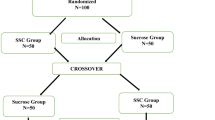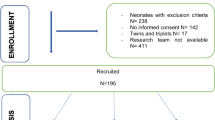Abstract
Objective
To compare the efficacy of SSC with oral Sucrose for pain management in preterm neonates.
Methodology
Parallel-group, assessor-blinded randomized control trial conducted from February-June 2017 at a level 3B-NICU. Hundred preterm neonates (29-0/7 to 36-6/7 weeks gestational age) requiring heel-stick were randomly assigned (1:1), to SSC (50, Group-A) and Sucrose (50, Group-B). In Group-A, SSC was provided at least 10 min before the procedure. In Group-B, 0.2 ml of oral Sucrose was provided 2 min before the procedure. Blinded assessment of Premature Infant Pain Profile (PIPP) score was done 30 s post-procedure using recorded videos.
Results
Baseline variables were [Mean(SD)] gestational age [32.79(2.34) weeks], age [14.04(11.10) days] and birth weight [1.62(0.35) kilograms]. PIPP score was less in group- A vs. B but could not achieve statistical significance [Mean(SD): 7.74(2.43) vs. 8.1(2.82), p = 0.50 CI of the difference: (−1.40,0.68)].
Conclusions
SSC and Sucrose have comparable efficacy in managing pain in premature neonates.


Similar content being viewed by others
References
Carbajal R, Rousset A, Danan C, Coquery S, Nolent P, Ducrocq S, et al. Epidemiology and treatment of painful procedures in neonates in intensive care units. JAMA. 2008;300:60–70.
Fitzgerald M. The development of nociceptive circuits. Nat Rev Neurosci. 2005;6:507–20.
Kostović I, Judaš M. Correlation between the sequential ingrowth of afferents and transient patterns of cortical lamination in preterm infants. Anat Rec. 2002;267:1–6.
Volpe JJ. Brain injury in premature infants: a complex amalgam of destructive and developmental disturbances. Lancet Neurol. 2009;8:110–24.
Qu Y, Vadivelu S, Choi L, Liu S, Lu A, Lewis B, et al. Neurons derived from embryonic stem (ES) cells resemble normal neurons in their vulnerability to excitotoxic death. Exp Neurol. 2003;184:326–36.
McDonald JW, Johnston MV. Physiological and pathophysiological roles of excitatory amino acids during central nervous system development. Brain Res Rev. 1990;15:41–70.
Brummelte S, Grunau RE, Chau V, Poskitt KJ, Brant R, Vinall J, et al. Procedural pain and brain development in premature newborns. Ann Neurol. 2012;71:385–96.
Smith GC, Gutovich J, Smyser C, Pineda R, Newnham C, Tjoeng TH, et al. Neonatal intensive care unit stress is associated with brain development in preterm infants. Ann Neurol. 2011;70:541–9.
Anand KJ, Aranda JV, Berde CB, Buckman S, Capparelli EV, Carlo W, et al. Summary proceedings from the neonatal pain-control group. Pediatrics. 2006;117(Suppl. 1):S9–S22.
Schwaller F, Fitzgerald M. The consequences of pain in early life: Injury induced plasticity in developing pain pathways. Eur J Neurosci. 2014;39:344–52.
Lyngstad LT, Tandberg BS, Storm H, Ekeberg BL, Moen A. Does skin-to-skin contact reduce stress during diaper change in preterm infants? Early Hum Dev. 2014;90:169–72.
Mitchell AJ, Yates CC, Williams DK, Chang JY, Hall R. Does daily kangaroo care provide sustained pain and stress relief in preterm infants? J Neonatal-Perinat Med. 2013;6:45–52.
Kostandy R, Anderson GC, Good M. Skin-to-skin contact diminishes pain from hepatitis B vaccine injection in healthy full-term neonates. Neonatal Netw: Nn. 2013;32:274–80.
Nimbalkar SM, Chaudhary NS, Gadhavi KV, Phatak A. Kangaroo mother care in reducing pain in preterm neonates on heel prick. Indian J Pediatr. 2013;80:6–10.
Johnston C, Campbell Yeo M, Disher T, Benoit B, Fernandes A, Streiner D, et al. Skin to skin care for procedural pain in neonates. Cochrane Database Syst. Rev., 2017;2:CD008435.
Shukla VV, Bansal S, Nimbalkar A, Chapla A, Phatak A, Patel D, et al. Pain control interventions in preterm neonates: a randomized controlled trial. Indian Pediatr. 2018;55:292–6.
Stevens B, Johnston C, Franck L, Petryshen P, Jack A, Foster G. The efficacy of developmentally sensitive interventions and sucrose for relieving procedural pain in very low birth weight neonates. Nurs Res. 1999;48:35–43.
Stevens B, Taddio A, Ohlsson A, Einarson T. The efficacy of sucrose for relieving procedural pain in neonates—a systematic review and meta analysis. Acta Paediatr. 1997;86:837–42.
Gibbins S, Stevens B, Hodnett E, Pinelli J, Ohlsson A, Darlington G. Efficacy and safety of sucrose for procedural pain relief in preterm and term neonates. Nurs Res. 2002;51:375–82.
Johnston C, Campbell-Yeo M, Fernandes A, Inglis D, Streiner D, Zee R. Skin-to-skin care for procedural pain in neonates. Cochrane Database Syst Rev. 2014;1:CD008435.
Campbell-Yeo M, Johnston C, Benoit B, Latimer M, Vincer M, Walker CD, et al. Trial of repeated analgesia with Kangaroo mother care (TRAKC Trial). BMC Pediatr. 2013;13:182.
Charpak N, Ruiz JG, Zupan J, Cattaneo A, Figueroa Z, Tessier R, et al. Kangaroo mother care: 25 years after. Acta Paediatrics. 2005;94:514–22.
Hake-Brooks SJ, Anderson GC. Kangaroo care and breastfeeding of mother-preterm infant dyads 0-18 months: a randomized, controlled trial. Neonatal Netw. 2008;27:151–9.
Ferber SG, Makhoul IR. The effect of skin-to-skin contact (kangaroo care) shortly after birth on the neurobehavioral responses of the term newborn: a randomized, controlled trial. Pediatrics. 2004;113:858–65.
Sosa R, Kennell JH, Klaus M, Urrutia JJ. The effect of early mother-infant contact on breast feeding, infection and growth. Ciba Foundation Symposium. 1976;(45)179–93.
Conde-Agudelo A, Diaz-Rossello JL. Kangaroo mother care to reduce morbidity and mortality in low birthweight infants. Cochrane Database Syst Rev. 2016;(3)Cd002771.
Johnston CC, Filion F, Snider L, Majnemer A, Limperopoulos C, Walker CD, et al. Routine sucrose analgesia during the first week of life in neonates younger than 31 weeks’ postconceptional age. Pediatrics. 2002;110:523–8.
Sarnat HB, Sarnat MS. Neonatal encephalopathy following fetal distress: a clinical and electroencephalographic study. Arch Neurol. 1976;33:696–705.
Papile L.-A, Munsick-Bruno G, Schaefer A. Relationship of cerebral intraventricular hemorrhage and early childhood neurologic handicaps. J Pediatr. 1983;103:273–7.
Stevens B, Johnston C, Petryshen P, Taddio A. Premature infant pain profile: development and initial validation. Clin J Pain. 1996;12:13–22.
Gathwala G, Singh B, Singh J. Effect of Kangaroo mother care on physical growth, breastfeeding and its acceptability. Trop Doct. 2010;40:199–202.
Beiranvand S, Valizadeh F, Hosseinabadi R, Pournia Y. The effects of skin-to-skin contact on temperature and breastfeeding successfulness in full-term newborns after cesarean delivery. Int J Pediatr. 2014;2014:846486.
Zhou J, Shukla VV, John D, Chen C. Human milk feeding as a protective factor for retinopathy of prematurity: a meta-analysis. Pediatrics. 2015;136:e1576–e1586.
Ohgi S, Fukuda M, Moriuchi H, Kusumoto T, Akiyama T, Nugent JK, et al. Comparison of kangaroo care and standard care: behavioral organization, development, and temperament in healthy, low-birth-weight infants through 1 year. J Perinatol. 2002;22:374–9.
Ludington-Hoe SM, Anderson GC, Swinth JY, Thompson C, Hadeed AJ. Randomized controlled trial of kangaroo care: cardiorespiratory and thermal effects on healthy preterm infants. Neonatal Netw: Nn. 2004;23:39–48.
Morelius E, Ortenstrand A, Theodorsson E, Frostell A. A randomised trial of continuous skin-to-skin contact after preterm birth and the effects on salivary cortisol, parental stress, depression, and breastfeeding. Early Hum Dev. 2015;91:63–70.
Dordevic G, Jovanovic B, Dordevic M. An early contact with the baby--benefit for the mother. Med Pregl. 2008;61:576–9.
Marin Gabriel MA, Llana Martin I, Lopez Escobar A, Fernandez Villalba E, Romero Blanco I, Touza Pol P. Randomized controlled trial of early skin-to-skin contact: effects on the mother and the newborn. Acta Paediatr. 2010;99:1630–4.
Bigelow AE, Littlejohn M, Bergman N, McDonald C. The relation between early mother-infant skin-to-skin contact and later maternal sensitivity in South African mothers of low birth weight infants. Infant Ment Health J. 2010;31:358–77.
Stevens B, McGrath P, Gibbins S, Beyene J, Breau L, Camfield C, et al. Procedural pain in newborns at risk for neurologic impairment. Pain. 2003;105:27–35.
Author contributions:
Dr. VS-conceptualized and planned the study, drafted the proposal and manuscript, planned and oversaw data collection, revised the manuscript and consented to the final manuscript as submitted. Dr. AC contributed to data collection, analysis of study, drafting the manuscript and consented to the final manuscript. Dr. JU contributed to data collection, analysis of study, and consented to the final manuscript. Dr. AN conceptualized and devised the study, analyzed the data, contributed to manuscript writing, and consented to the final manuscript. Mr. AP contributed to study design, analyzed the data, provided important intellectual inputs to the manuscript, and consented to the final manuscript submitted. Dr. SN conceptualized, planned, and supervised the progress of the study, analyzed the data, provided important intellectual inputs to the manuscript, revised the manuscript, and consented to the final manuscript as submitted. He will be the guarantor for the study.
Author information
Authors and Affiliations
Corresponding author
Ethics declarations
Conflict of interest
The authors declare that they have no conflict of interest.
Rights and permissions
About this article
Cite this article
Shukla, V., Chapla, A., Uperiya, J. et al. Sucrose vs. skin to skin care for preterm neonatal pain control—a randomized control trial. J Perinatol 38, 1365–1369 (2018). https://doi.org/10.1038/s41372-018-0193-9
Received:
Revised:
Accepted:
Published:
Issue Date:
DOI: https://doi.org/10.1038/s41372-018-0193-9
- Springer Nature America, Inc.
This article is cited by
-
The effects of different procedures on pain levels in preterm and term infants in neonatal intensive care unit: a cross‐sectional survey of pain assessment in newborns
Irish Journal of Medical Science (1971 -) (2023)
-
Blinded randomized crossover trial: Skin-to-skin care vs. sucrose for preterm neonatal pain
Journal of Perinatology (2020)
-
Music therapy and retinopathy of prematurity screening: using recorded maternal singing and heartbeat for post exam recovery
Journal of Perinatology (2020)




